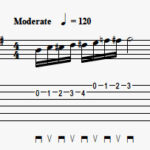The Gibson Firebird stands as a testament to audacious design and sonic innovation in the world of electric guitars. Among its diverse iterations, the “Reverse” Firebird models, launched in 1963, are particularly captivating for collectors and players alike. Often sparking curiosity in guitar showrooms, the Firebird series, including its Thunderbird bass counterparts, can initially seem complex due to its various body styles and appointments. This guide aims to demystify the Reverse Firebird, offering a clear understanding of its anatomy and the distinctions between its celebrated models.
The Birth of a Legend: Automotive Inspiration and Reverse Design
Gibson introduced the Firebird and Thunderbird series in 1963, revolutionary designs conceived by automotive stylist Ray Dietrich. Drawing inspiration from the sleek aesthetics of mid-century vehicles, Dietrich imbued these instruments with flowing lines, pronounced curves, and a distinctive visual identity, aiming to create a modern and striking guitar to rival Fender’s dominance. The result was the “Reverse” Firebird, the first iteration of this iconic model.
The Reverse Firebird is characterized by its solid mahogany construction and neck-through design. Initially, the body comprised two mahogany pieces forming the neck and body center, with additional “wings” attached to create its distinctive shape. Towards the end of 1963, Gibson transitioned to a more robust 7-piece laminate construction, featuring a five-piece neck and center section flanked by two wings. This modification enhanced the structural integrity of the neck and headstock. Within the Reverse Firebird family, four distinct models emerged – the Firebird I, III, V, and VII – each denoting increasing levels of ornamentation and features, mirroring Gibson’s approach with their ES thinline series. All models were originally available in Sunburst and a range of vibrant Custom Colors. Early models can also be identified by the absence of the Firebird emblem on the pickguard.
Decoding the Reverse Firebird Models: I, III, V, and VII
Each Reverse Firebird model offers a unique set of features and appointments, catering to different player preferences and budgets. Here’s a detailed breakdown:
Firebird I: The Stripped-Down Rocker
The Firebird I is the most minimalist of the Reverse Firebirds, featuring a single mini-humbucker pickup. This pickup was derived from Epiphone’s New Yorker pickup, adopted by Gibson after acquiring Epiphone. The Firebird I came equipped with a stop bar wrap-around tailpiece and a short vibrola with a “spoon handle” tremolo arm. Visually, it sports understated dot inlays on an unbound rosewood fretboard, a raised “step” area with a holly veneer on the headstock, and functional banjo-style tuners. Reflecting its single pickup configuration, the Firebird I has straightforward controls: one volume and one tone knob. All hardware on the Firebird I during this period was nickel-plated.
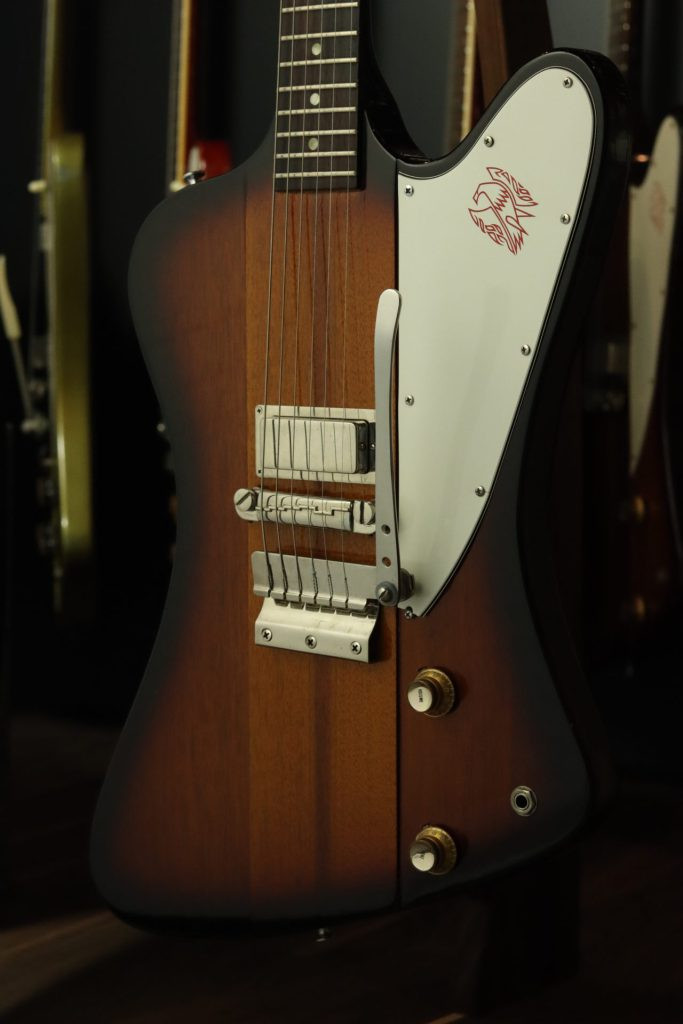 1964 Gibson Firebird I in Sunburst
1964 Gibson Firebird I in Sunburst
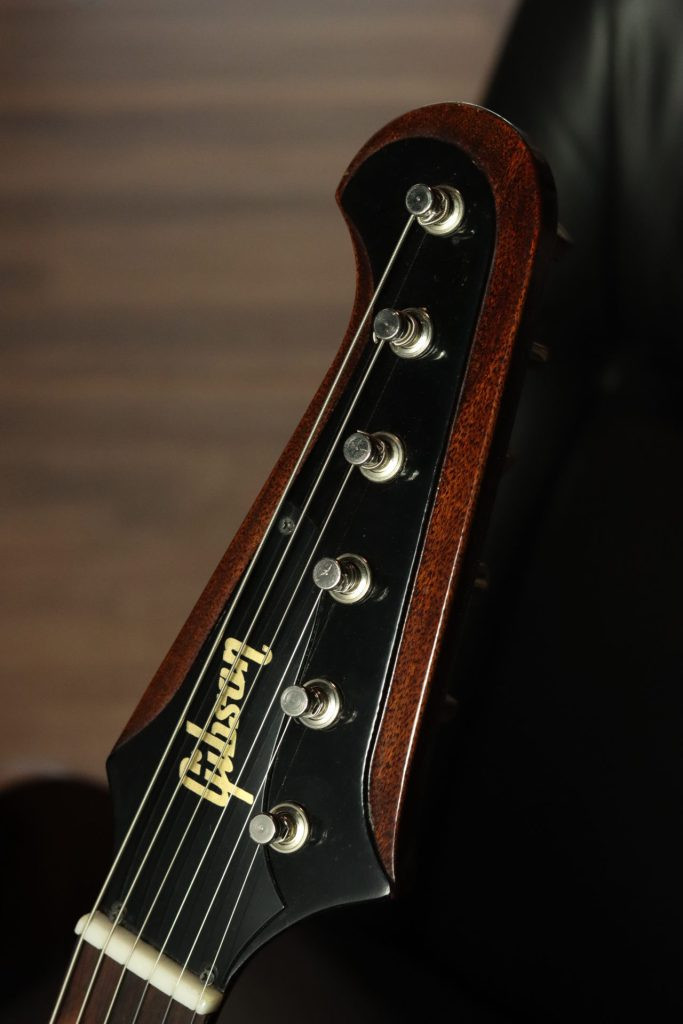 Firebird I Headstock with Raised Holly Veneer
Firebird I Headstock with Raised Holly Veneer
Firebird III: Adding Versatility with Dual Pickups
Building upon the foundation of the Firebird I, the Firebird III maintains the same body construction, bound rosewood fretboard, dot inlays, raised holly veneer on the headstock, and banjo-style tuners. However, it introduces significant enhancements in electronics and hardware. Most Firebird III models were fitted with short vibratos and metal “spoon handle” trem arms. Crucially, it boasts two mini-humbucker pickups, offering a wider tonal palette, selectable via a three-way switch. Four control knobs provide independent volume and tone adjustments for each pickup. Like the I, the Firebird III features nickel hardware and a bound fretboard.
 1964 Gibson Firebird III in Sunburst
1964 Gibson Firebird III in Sunburst
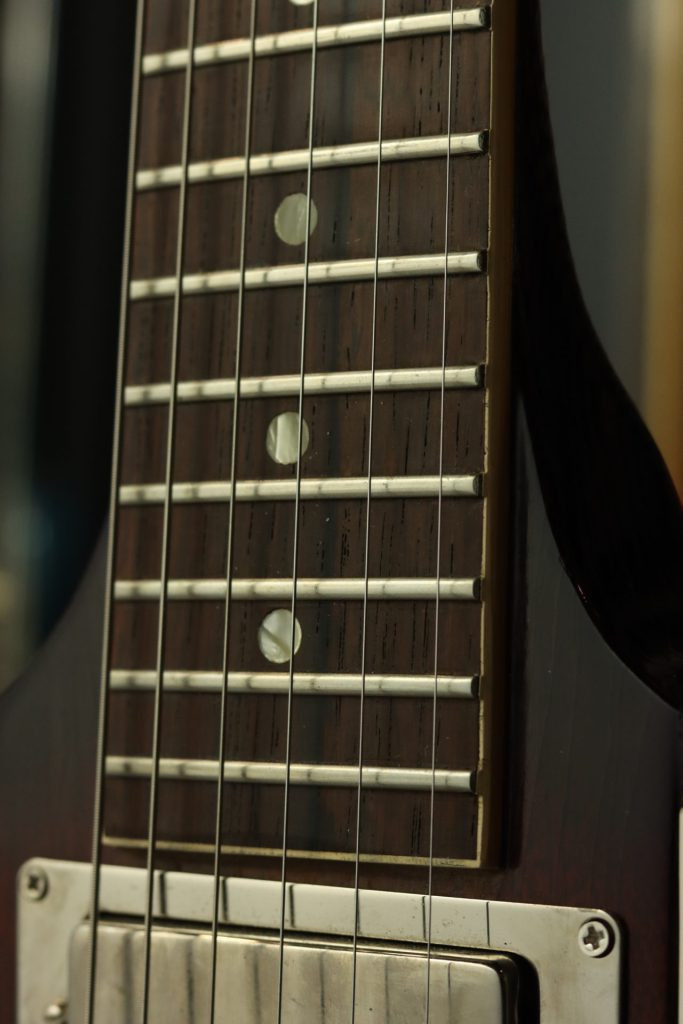 1964 Gibson Firebird III Bound Rosewood Fingerboard
1964 Gibson Firebird III Bound Rosewood Fingerboard
Firebird V: Stepping Up in Style and Features
The Firebird V shares the same fundamental body construction as the I and III but marks a step up in terms of visual appointments and features. It incorporates pearloid trapezoid inlays on the fretboard, adding a touch of elegance, and a longer Maestro Lyre vibrola with a plastic handle for enhanced vibrato capabilities. Despite these upgrades, the Firebird V retains the dual mini-humbucker configuration, three-way selector switch, and four control knobs of the Firebird III. Nickel hardware remains consistent on the Firebird V.
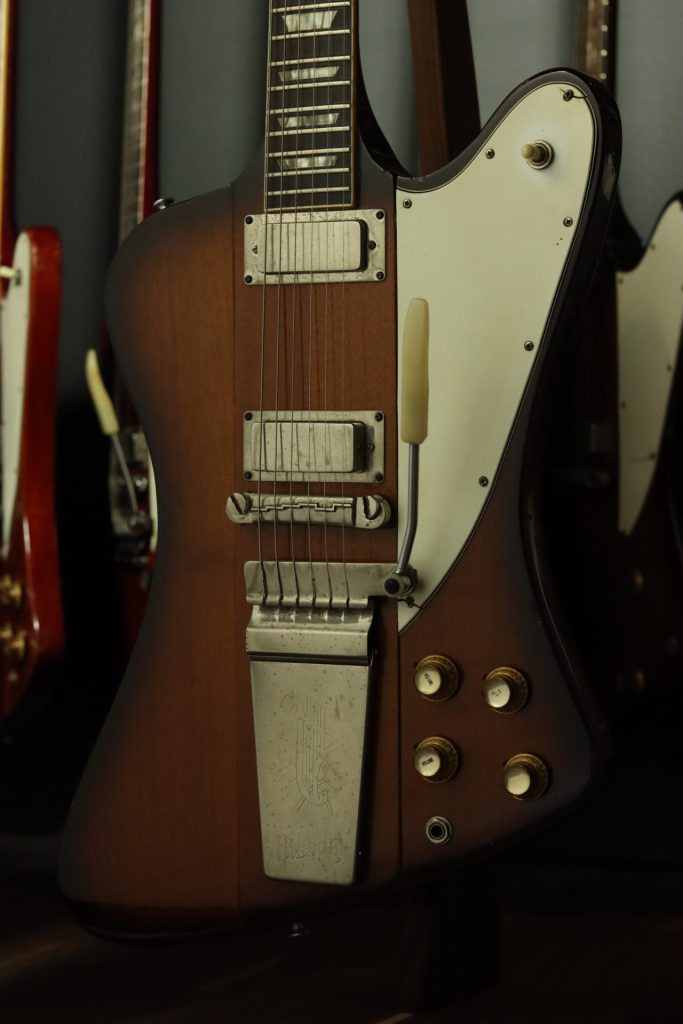 1963 Gibson Firebird V in Sunburst
1963 Gibson Firebird V in Sunburst
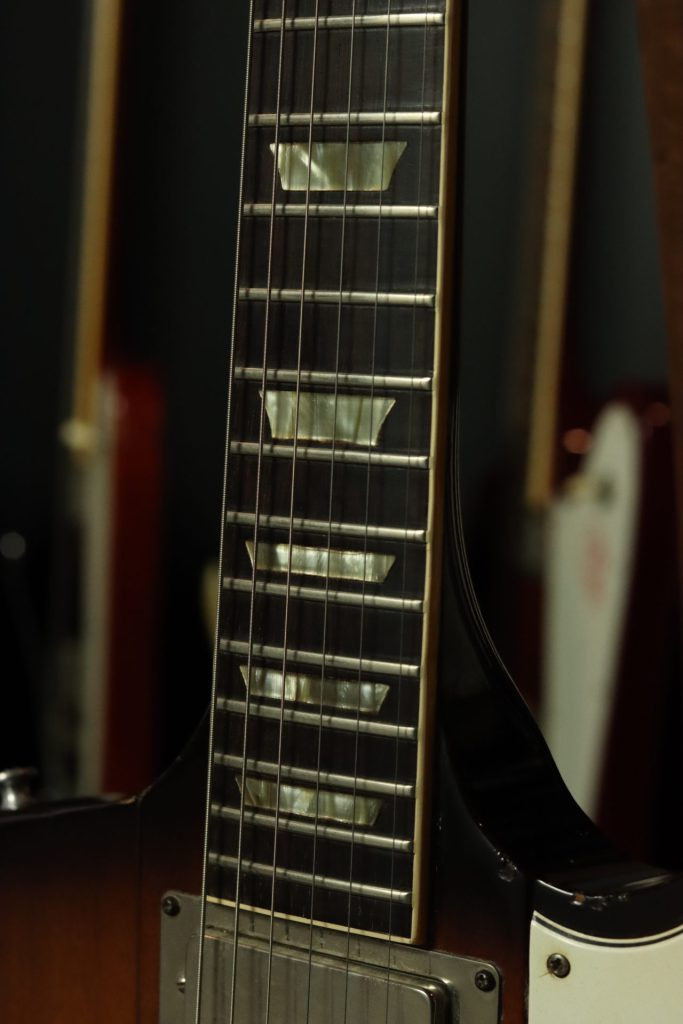 1963 Gibson Firebird V Bound Rosewood Fingerboard
1963 Gibson Firebird V Bound Rosewood Fingerboard
Firebird VII: The Pinnacle of Reverse Firebird Luxury
The Firebird VII represents the most luxurious and feature-rich model in the Reverse Firebird lineup, analogous to the ES-355 in Gibson’s ES series. While maintaining the standard body construction, the VII distinguishes itself through its premium appointments. It features a bound ebony fretboard, offering a darker and smoother playing surface, and opulent genuine Mother Of Pearl block inlays, replacing the pearloid trapezoids of the V. Hardware is upgraded from nickel to gold-plated, adding a touch of prestige. The Firebird VII is equipped with three mini-humbucker pickups, delivering a versatile and powerful tonal range. Wired similarly to a Les Paul Custom, it includes a three-way selector switch and four control knobs. Finally, it features a gold Lyre Vibrola with a plastic handle, completing its top-tier status.
 1965 Gibson Firebird VII in Sunburst
1965 Gibson Firebird VII in Sunburst
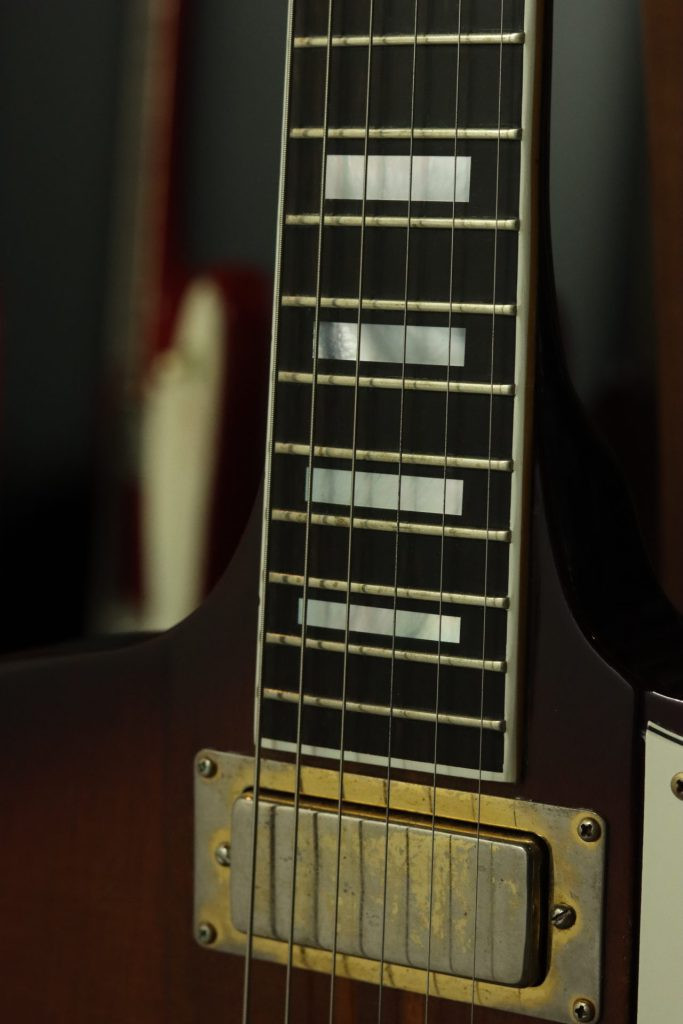 1965 Gibson Firebird VII Bound Ebony Fingerboard
1965 Gibson Firebird VII Bound Ebony Fingerboard
Navigating the Vintage Market: Key Considerations for Reverse Firebird Shoppers
When venturing into the market for vintage Gibson Reverse Firebird Guitars from the 1963-1965 era, understanding these model-specific appointments is crucial. Remember that Gibson, much like Fender, was known for accommodating custom orders and making adjustments as needed. Therefore, variations and exceptions to standard specifications can exist. When in doubt, consulting with a vintage guitar specialist is highly recommended to ensure you acquire the instrument that best suits your needs and preferences.
To further your Firebird knowledge, explore our companion piece on “Non-Reverse” Firebirds, which details the evolution and differences introduced in the subsequent iteration of this iconic guitar.
For a quick visual guide, refer to these key feature indicators:
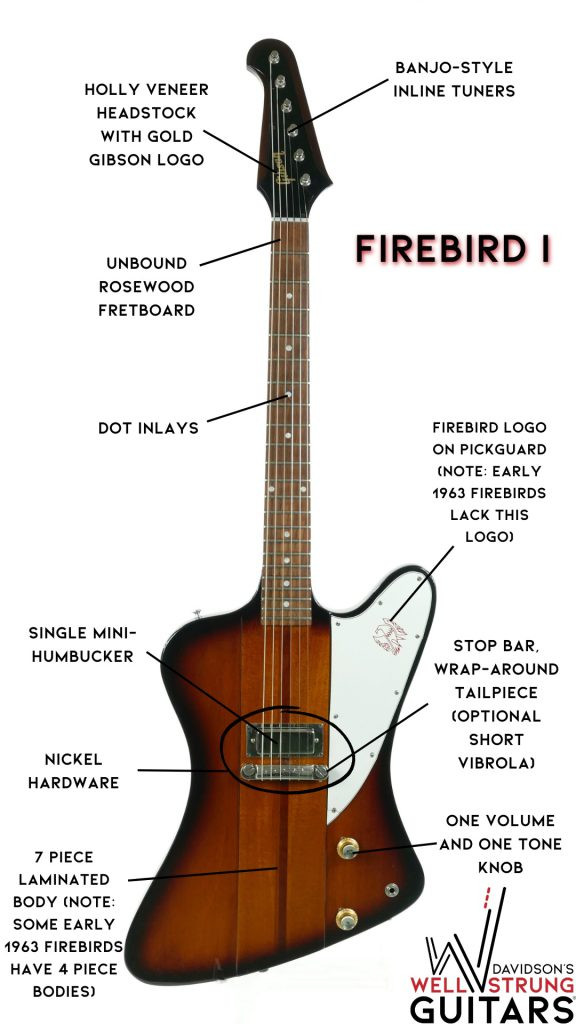 Reverse Firebird Body Shape
Reverse Firebird Body Shape
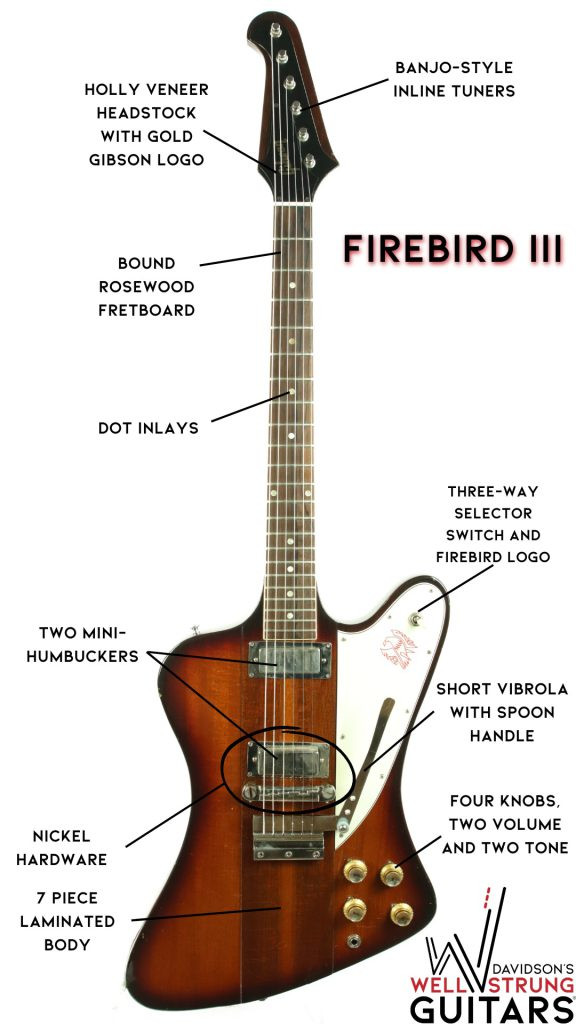 Banjo-Style Inline Tuners
Banjo-Style Inline Tuners
 Firebird Pickguard Shape
Firebird Pickguard Shape


